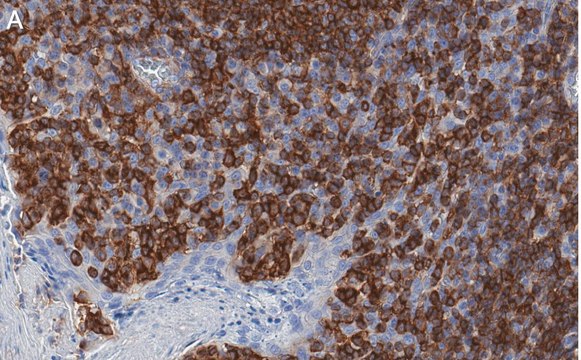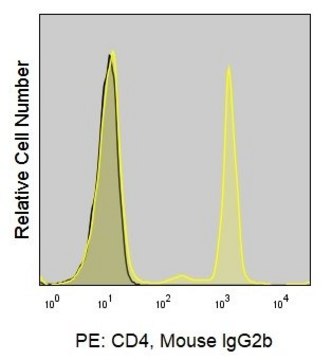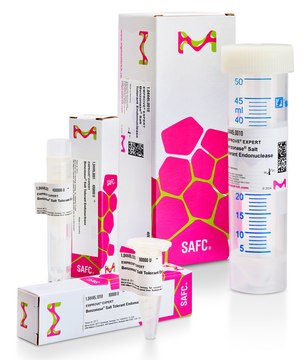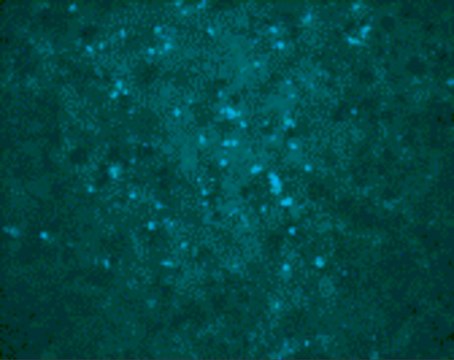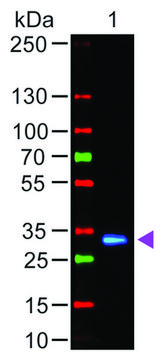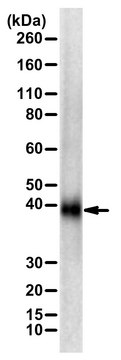MAB8151
Anti-West Nile Virus/Kunjin Antibody, Envelope, clone 3.91D
ascites fluid, clone 3.91D, Chemicon®
Sign Into View Organizational & Contract Pricing
All Photos(1)
UNSPSC Code:
12352203
eCl@ss:
32160702
NACRES:
NA.41
Recommended Products
biological source
mouse
Quality Level
antibody form
ascites fluid
clone
3.91D, monoclonal
species reactivity
human
manufacturer/tradename
Chemicon®
technique(s)
ELISA: suitable
immunofluorescence: suitable
immunohistochemistry: suitable
western blot: suitable
isotype
IgG3
shipped in
wet ice
Specificity
Specific for the major envelope protein E of West Nile/Kunjin virus. Kunjin (KUN) is very closely related to some strains of West Nile virus, and has been classified as a subtype of West Nile.
Immunogen
Epitope: Envelope
Application
Anti-West Nile Virus/Kunjin Antibody, Envelope, clone 3.91D is an antibody against West Nile Virus/Kunjin for use in ELISA, IF, WB, IH.
Physical form
Ascites with 0.1% Sodium Azide.
Storage and Stability
Store at -20°C in undiluted aliquots. May be stored at 2-8°C for short term use.
Avoid repeated freeze thaw cycles.
Avoid repeated freeze thaw cycles.
Other Notes
Concentration: Please refer to the Certificate of Analysis for the lot-specific concentration.
Legal Information
CHEMICON is a registered trademark of Merck KGaA, Darmstadt, Germany
WGK
nwg
Flash Point(F)
Not applicable
Flash Point(C)
Not applicable
Certificates of Analysis (COA)
Search for Certificates of Analysis (COA) by entering the products Lot/Batch Number. Lot and Batch Numbers can be found on a product’s label following the words ‘Lot’ or ‘Batch’.
Already Own This Product?
Find documentation for the products that you have recently purchased in the Document Library.
A PCR-based protocol for the generation of a recombinant West Nile virus.
Akihiko Maeda,Ryo Murata,Minoru Akiyama,Ikuo Takashima,Hiroaki Kariwa,Tomomasa Watanabe et al.
Virus Research null
Characterization of West Nile viruses isolated from captive American Flamingoes (Phoenicopterus ruber) in Medellin, Colombia.
Osorio, JE; Ciuoderis, KA; Lopera, JG; Piedrahita, LD; Murphy, D; Levasseur, J; Carrillo et al.
The American Journal of Tropical Medicine and Hygiene null
Manoj N Krishnan
Methods in molecular biology (Clifton, N.J.), 1435, 115-127 (2016-05-18)
The West Nile virus (WNV) infection is a major medical problem for humans and some domesticated animals. WNV infection of host cells involves the interplay of the virus with several host factors. Identification of the host factors impacting on WNV
Rungrat Saiyasombat et al.
Virology journal, 11, 150-150 (2014-08-26)
Most known flaviviruses, including West Nile virus (WNV), are maintained in natural transmission cycles between hematophagous arthropods and vertebrate hosts. Other flaviviruses such as Modoc virus (MODV) and Culex flavivirus (CxFV) have host ranges restricted to vertebrates and insects, respectively.
The emergence of West Nile virus: the Australian connection.
R A Hall
Viral immunology, 13(4), 447-461 (2001-02-24)
Our team of scientists has experience in all areas of research including Life Science, Material Science, Chemical Synthesis, Chromatography, Analytical and many others.
Contact Technical Service